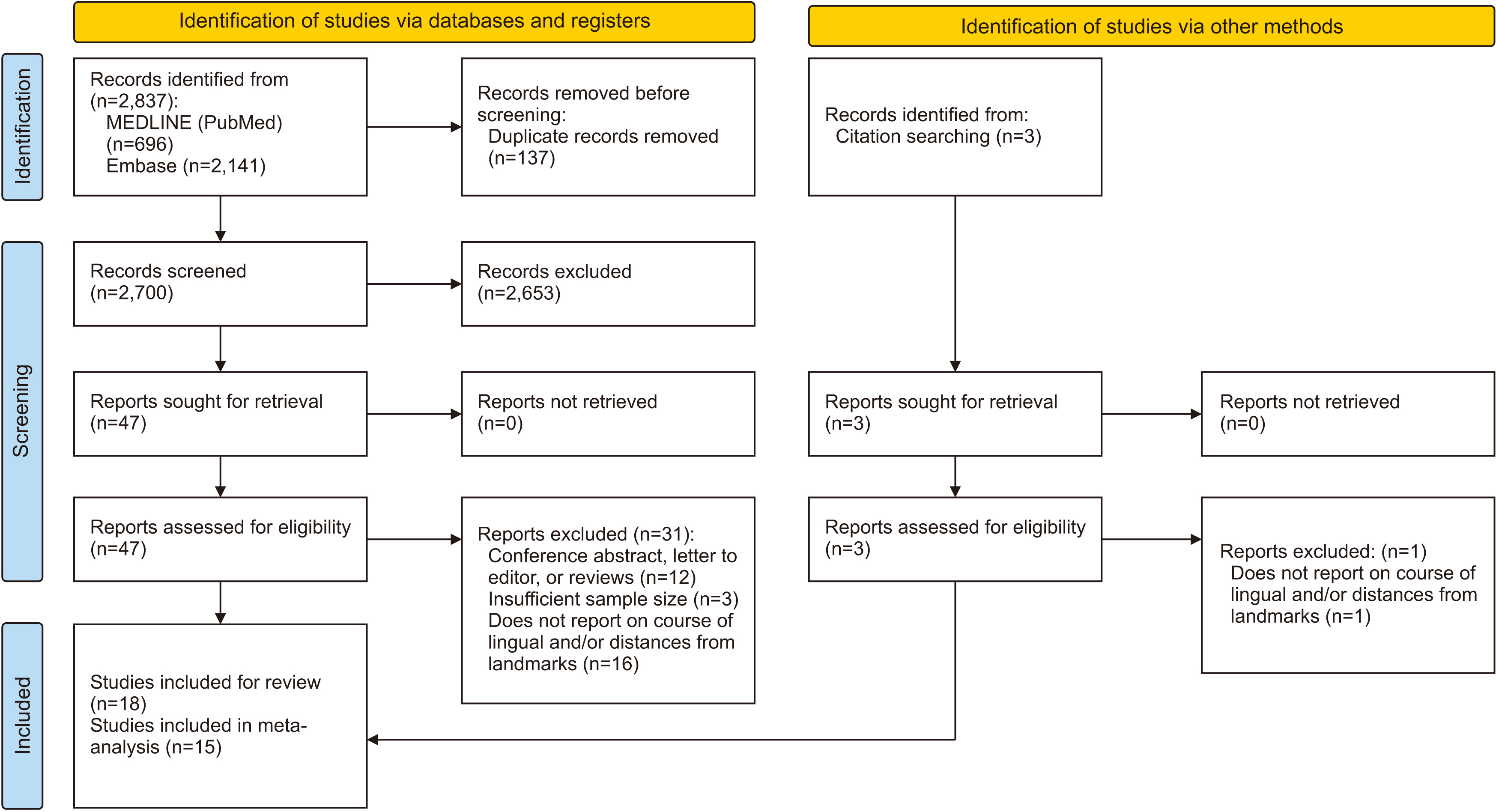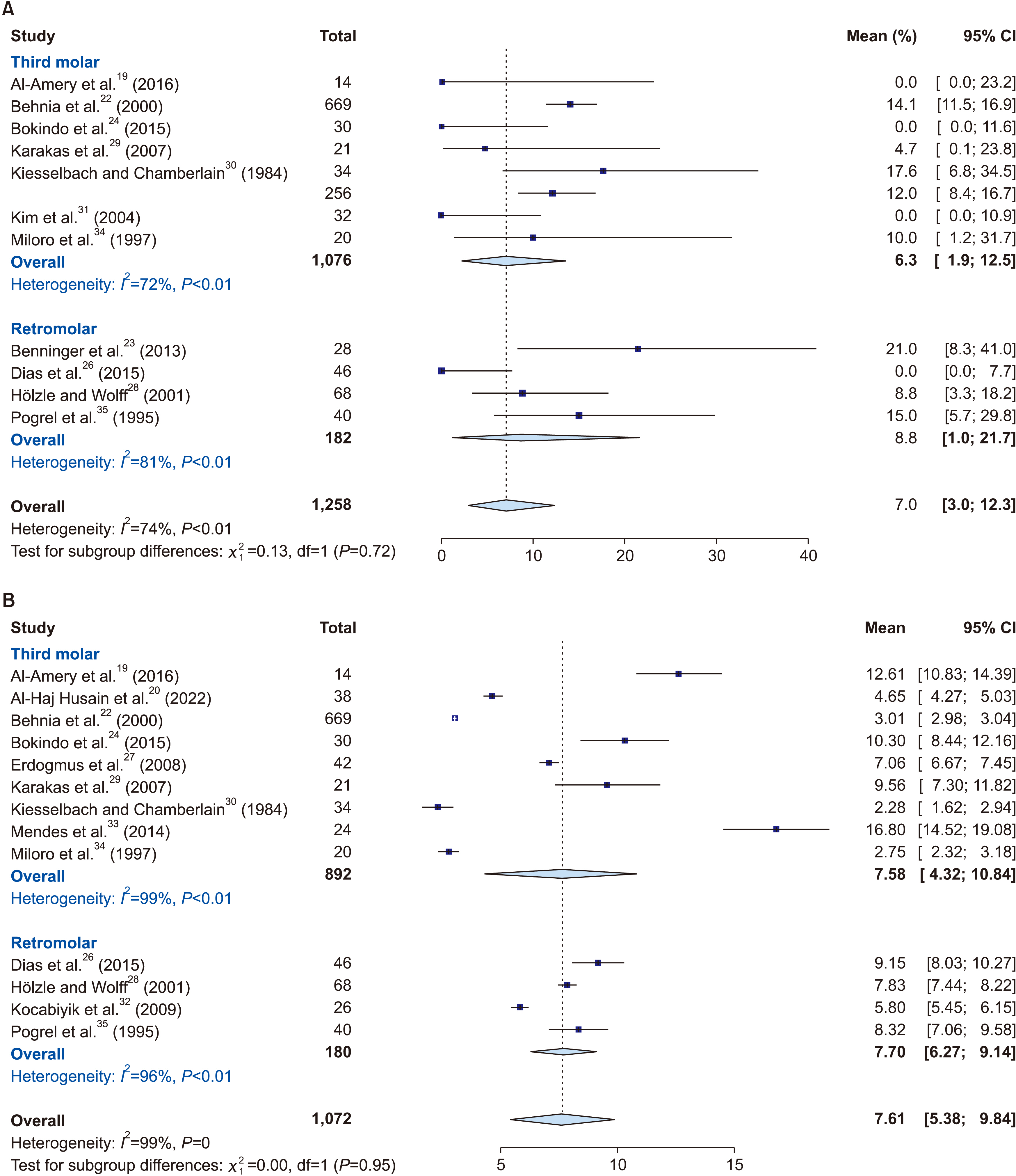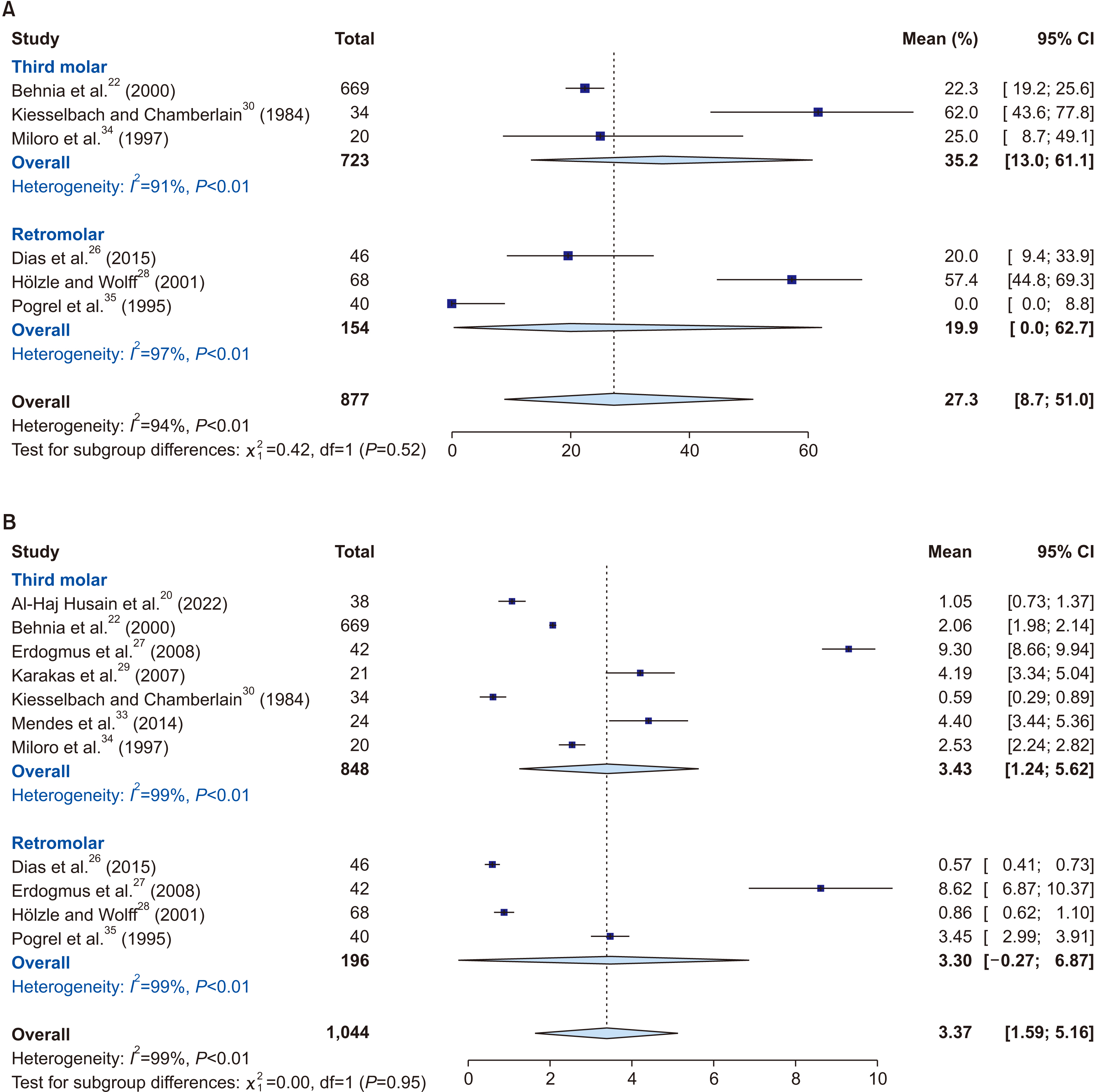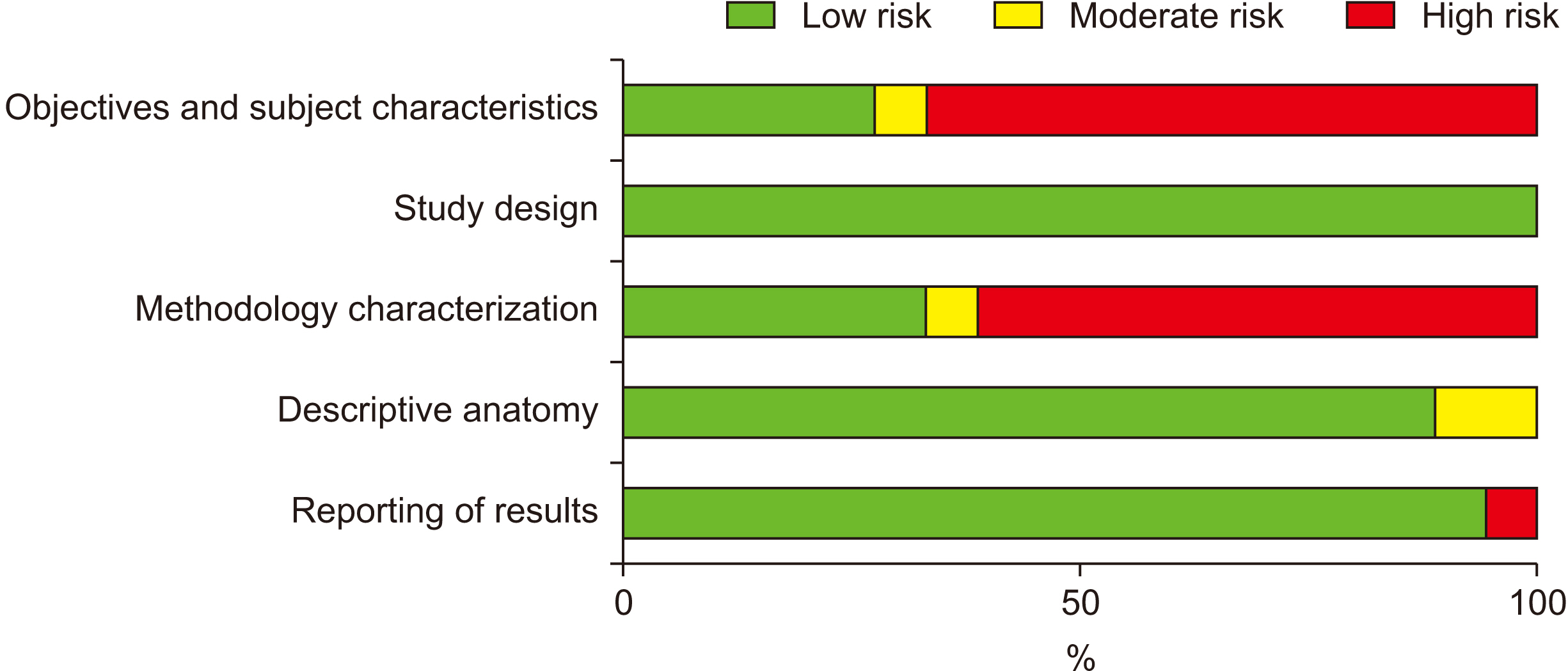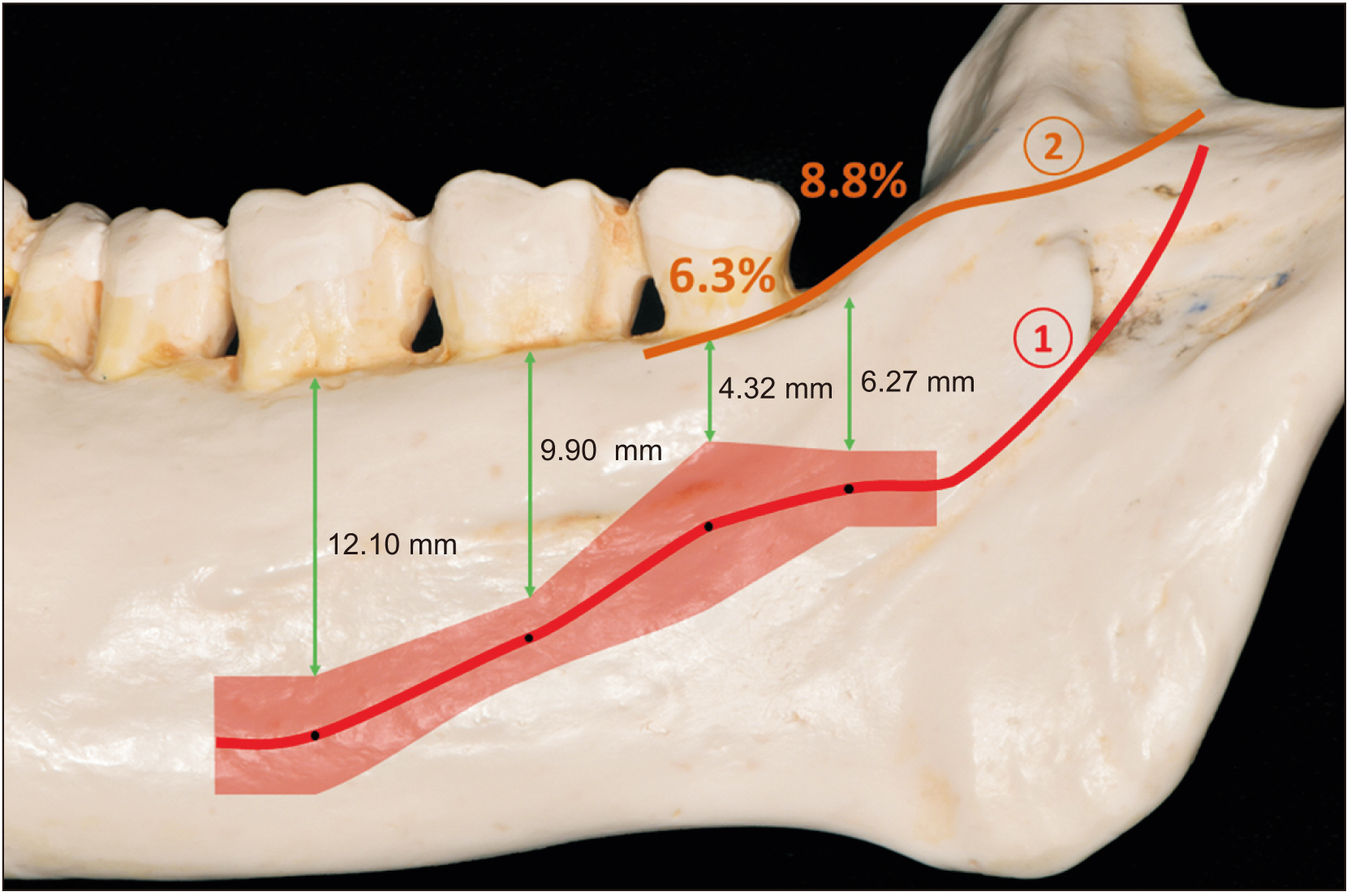J Korean Assoc Oral Maxillofac Surg.
2023 Aug;49(4):171-183. 10.5125/jkaoms.2023.49.4.171.
Mapping out the surgical anatomy of the lingual nerve: a systematic review and meta-analysis
- Affiliations
-
- 1Faculty of Dentistry, National University of Singapore, Singapore
- 2National Dental Centre Singapore, Singapore
- KMID: 2545582
- DOI: http://doi.org/10.5125/jkaoms.2023.49.4.171
Abstract
Objectives
Understanding the lingual nerve’s precise location is crucial to prevent iatrogenic injury. This systematic review seeks to determine the lingual nerve’s most probable topographical location in the posterior mandible.
Materials and Methods
Two electronic databases were searched, identifying studies reporting the lingual nerve’s position in the posterior mandible. Anatomical data in the vertical and horizontal dimensions at the retromolar and molar regions were collected for meta-analyses.
Results
Of the 2,700 unique records identified, 18 studies were included in this review. In the vertical plane, 8.8% (95% confidence interval [CI], 1.0%-21.7%) and 6.3% (95% CI, 1.9%-12.5%) of the lingual nerves coursed above the alveolar crest at the retromolar and third molar regions. The mean vertical distance between the nerve and the alveolar crest ranged from 12.10 to 4.32 mm at the first to third molar regions. In the horizontal plane, 19.9% (95% CI, 0.0%-62.7%) and 35.2% (95% CI, 13.0%-61.1%) of the lingual nerves were in contact with the lingual plate at the retromolar and third molar regions.
Conclusion
This systematic review mapped out the anatomical location of the lingual nerve in the posterior mandible, highlighting regions that warrant additional caution during surgeries to avoid iatrogenic lingual nerve injuries.
Figure
Reference
-
References
1. Fagan SE, Roy W. Aboubakr S, Abu-Ghosh A, Adibi Sedeh P, Aeby TC, Aeddula NR, Agadi S, editors. 2023. Anatomy, head and neck, lingual nerve. StatPearls. StatPearls Publishing.2. Blackburn CW. 1990; A method of assessment in cases of lingual nerve injury. Br J Oral Maxillofac Surg. 28:238–45. https://doi.org/10.1016/0266-4356(90)90059-t. DOI: 10.1016/0266-4356(90)90059-T. PMID: 2207042.
Article3. Mason DA. 1988; Lingual nerve damage following lower third molar surgery. Int J Oral Maxillofac Surg. 17:290–4. https://doi.org/10.1016/s0901-5027(88)80005-5. DOI: 10.1016/S0901-5027(88)80005-5. PMID: 3143774.
Article4. Van der Cruyssen F, Peeters F, Gill T, De Laat A, Jacobs R, Politis C, et al. 2020; Signs and symptoms, quality of life and psychosocial data in 1331 post-traumatic trigeminal neuropathy patients seen in two tertiary referral centres in two countries. J Oral Rehabil. 47:1212–21. https://doi.org/10.1111/joor.13058. DOI: 10.1111/joor.13058. PMID: 32687637. PMCID: PMC7540026.
Article5. Shawky M, Mosleh M, Jan AM, Jadu FM. 2016; Meta-analysis of the incidence of lingual nerve deficits after mandibular bilateral sagittal split osteotomy. J Craniofac Surg. 27:561–4. https://doi.org/10.1097/scs.0000000000002450. DOI: 10.1097/SCS.0000000000002450. PMID: 26982111.
Article6. Gülicher D, Gerlach KL. 2001; Sensory impairment of the lingual and inferior alveolar nerves following removal of impacted mandibular third molars. Int J Oral Maxillofac Surg. 30:306–12. https://doi.org/10.1054/ijom.2001.0057. DOI: 10.1054/ijom.2001.0057. PMID: 11518353.
Article7. Hillerup S, Stoltze K. 2007; Lingual nerve injury in third molar surgery I. Observations on recovery of sensation with spontaneous healing. Int J Oral Maxillofac Surg. 36:884–9. https://doi.org/10.1016/j.ijom.2007.06.004. DOI: 10.1016/j.ijom.2007.06.004. PMID: 17766086.
Article8. Bataineh AB. 2001; Sensory nerve impairment following mandibular third molar surgery. J Oral Maxillofac Surg. 59:1012–7. discussion 1017. https://doi.org/10.1053/joms.2001.25827. DOI: 10.1053/joms.2001.25827. PMID: 11526568.
Article9. Gomes AC, Vasconcelos BC, de Oliveira e Silva ED, da Silva LC. 2005; Lingual nerve damage after mandibular third molar surgery: a randomized clinical trial. J Oral Maxillofac Surg. 63:1443–6. https://doi.org/10.1016/j.joms.2005.06.012. DOI: 10.1016/j.joms.2005.06.012. PMID: 16182911.
Article10. Valmaseda-Castellón E, Berini-Aytés L, Gay-Escoda C. 2000; Lingual nerve damage after third lower molar surgical extraction. Oral Surg Oral Med Oral Pathol Oral Radiol Endod. 90:567–73. https://doi.org/10.1067/moe.2000.110034. DOI: 10.1067/moe.2000.110034. PMID: 11077378.
Article11. Berberi A, Le Breton G, Mani J, Woimant H, Nasseh I. 1993; Lingual paresthesia following surgical placement of implants: report of a case. Int J Oral Maxillofac Implants. 8:580–2. PMID: 8112800.12. Tay AB, Zuniga JR. 2007; Clinical characteristics of trigeminal nerve injury referrals to a university centre. Int J Oral Maxillofac Surg. 36:922–7. https://doi.org/10.1016/j.ijom.2007.03.012. DOI: 10.1016/j.ijom.2007.03.012. PMID: 17875382.
Article13. Urban IA, Monje A, Lozada J, Wang HL. 2017; Principles for vertical ridge augmentation in the atrophic posterior mandible: a technical review. Int J Periodontics Restorative Dent. 37:639–45. https://doi.org/10.11607/prd.3200. DOI: 10.11607/prd.3200. PMID: 28817126.
Article14. Pippi R, Spota A, Santoro M. 2017; Prevention of lingual nerve injury in third molar surgery: literature review. J Oral Maxillofac Surg. 75:890–900. https://doi.org/10.1016/j.joms.2016.12.040. DOI: 10.1016/j.joms.2016.12.040. PMID: 28142010.
Article15. Lee J, Feng B, Park JS, Foo M, Kruger E. 2023; Incidence of lingual nerve damage following surgical extraction of mandibular third molars with lingual flap retraction: a systematic review and meta-analysis. PLoS One. 18:e0282185. https://doi.org/10.1371/journal.pone.0282185. DOI: 10.1371/journal.pone.0282185. PMID: 36848347. PMCID: PMC9970109.
Article16. Higgins JPT, Thomas J, Chandler J, Cumpston M, Li T, Page MJ, et al. 2022. Cochrane handbook for systematic reviews of interventions version 6.3 [Internet]. Cochrane;Available from: https://training.cochrane.org/handbook. cited 2023 Apr 18.17. Page MJ, McKenzie JE, Bossuyt PM, Boutron I, Hoffmann TC, Mulrow CD, et al. 2021; The PRISMA 2020 statement: an updated guideline for reporting systematic reviews. BMJ. 372:n71. https://doi.org/10.1136/bmj.n71. DOI: 10.1136/bmj.n71. PMID: 33782057. PMCID: PMC8005924.
Article18. Henry BM, Tomaszewski KA, Ramakrishnan PK, Roy J, Vikse J, Loukas M, et al. 2017; Development of the anatomical quality assessment (AQUA) tool for the quality assessment of anatomical studies included in meta-analyses and systematic reviews. Clin Anat. 30:6–13. https://doi.org/10.1002/ca.22799. DOI: 10.1002/ca.22799. PMID: 27718281.
Article19. Al-Amery SM, Nambiar P, Naidu M, Ngeow WC. 2016; Variation in lingual nerve course: a human cadaveric study. PLoS One. 11:e0162773. https://doi.org/10.1371/journal.pone.0162773. DOI: 10.1371/journal.pone.0162773. PMID: 27662622. PMCID: PMC5035068.
Article20. Al-Haj Husain A, Valdec S, Stadlinger B, Rücker M, Piccirelli M, Winklhofer S. 2022; Preoperative visualization of the lingual nerve by 3D double-echo steady-state MRI in surgical third molar extraction treatment. Clin Oral Investig. 26:2043–53. https://doi.org/10.1007/s00784-021-04185-z. DOI: 10.1007/s00784-021-04185-z. PMID: 34586501. PMCID: PMC8816737.
Article21. Aljamani S, Youngson C, Jarad F, O'Neill F. 2022; Electrical stimulation to clinically identify position of the lingual nerve: results of 50 subjects with reliability and correlation with MRI. Oral Maxillofac Surg. 26:253–60. https://doi.org/10.1007/s10006-021-00985-5. DOI: 10.1007/s10006-021-00985-5. PMID: 34255234. PMCID: PMC9162997.
Article22. Behnia H, Kheradvar A, Shahrokhi M. 2000; An anatomic study of the lingual nerve in the third molar region. J Oral Maxillofac Surg. 58:649–51. discussion 652–3. https://doi.org/10.1016/s0278-2391(00)90159-9. DOI: 10.1016/S0278-2391(00)90159-9. PMID: 10847287.
Article23. Benninger B, Kloenne J, Horn JL. 2013; Clinical anatomy of the lingual nerve and identification with ultrasonography. Br J Oral Maxillofac Surg. 51:541–4. https://doi.org/10.1016/j.bjoms.2012.10.014. DOI: 10.1016/j.bjoms.2012.10.014. PMID: 23182453.
Article24. Bokindo IK, Butt F, Hassanali J. 2015; Morphology and morphometry of the lingual nerve in relation to the mandibular third molar. Open J Stomatol. 5:6–11. https://doi.org/10.4236/ojst.2015.51002. DOI: 10.4236/ojst.2015.51002.
Article25. Chan HL, Leong DJ, Fu JH, Yeh CY, Tatarakis N, Wang HL. 2010; The significance of the lingual nerve during periodontal/implant surgery. J Periodontol. 81:372–7. https://doi.org/10.1902/jop.2009.090506. DOI: 10.1902/jop.2009.090506. PMID: 20192863.
Article26. Dias GJ, de Silva RK, Shah T, Sim E, Song N, Colombage S, et al. 2015; Multivariate assessment of site of lingual nerve. Br J Oral Maxillofac Surg. 53:347–51. https://doi.org/10.1016/j.bjoms.2015.01.011. DOI: 10.1016/j.bjoms.2015.01.011. PMID: 25662169.
Article27. Erdogmus S, Govsa F, Celik S. 2008; Anatomic position of the lingual nerve in the mandibular third molar region as potential risk factors for nerve palsy. J Craniofac Surg. 19:264–70. https://doi.org/10.1097/scs.0b013e31815c9411. DOI: 10.1097/scs.0b013e31815c9411. PMID: 18216699.
Article28. Hölzle FW, Wolff KD. 2001; Anatomic position of the lingual nerve in the mandibular third molar region with special consideration of an atrophied mandibular crest: an anatomical study. Int J Oral Maxillofac Surg. 30:333–8. https://doi.org/10.1054/ijom.2001.0064. DOI: 10.1054/ijom.2001.0064. PMID: 11518358.
Article29. Karakas P, Uzel M, Koebke J. 2007; The relationship of the lingual nerve to the third molar region using radiographic imaging. Br Dent J. 203:29–31. https://doi.org/10.1038/bdj.2007.584. DOI: 10.1038/bdj.2007.584. PMID: 17632483.
Article30. Kiesselbach JE, Chamberlain JG. 1984; Clinical and anatomic observations on the relationship of the lingual nerve to the mandibular third molar region. J Oral Maxillofac Surg. 42:565–7. https://doi.org/10.1016/0278-2391(84)90085-5. DOI: 10.1016/0278-2391(84)90085-5. PMID: 6590806.
Article31. Kim SY, Hu KS, Chung IH, Lee EW, Kim HJ. 2004; Topographic anatomy of the lingual nerve and variations in communication pattern of the mandibular nerve branches. Surg Radiol Anat. 26:128–35. https://doi.org/10.1007/s00276-003-0179-x. DOI: 10.1007/s00276-003-0179-x. PMID: 14586562.
Article32. Kocabiyik N, Varol A, Sencimen M, Ozan H. 2009; An unnamed branch of the lingual nerve: gingival branch. Br J Oral Maxillofac Surg. 47:214–7. https://doi.org/10.1016/j.bjoms.2008.07.197. DOI: 10.1016/j.bjoms.2008.07.197. PMID: 18778880.
Article33. Mendes MB, de Carvalho Leite Leal Nunes CM, de Almeida Lopes MC. 2014; Anatomical relationship of lingual nerve to the region of mandibular third molar. J Oral Maxillofac Res. 4:e2. https://doi.org/10.5037/jomr.2013.4402. DOI: 10.5037/jomr.2013.4402. PMID: 24478912. PMCID: PMC3904728.
Article34. Miloro M, Halkias LE, Slone HW, Chakeres DW. 1997; Assessment of the lingual nerve in the third molar region using magnetic resonance imaging. J Oral Maxillofac Surg. 55:134–7. https://doi.org/10.1016/s0278-2391(97)90228-7. DOI: 10.1016/S0278-2391(97)90228-7. PMID: 9024349.
Article35. Pogrel MA, Renaut A, Schmidt B, Ammar A. 1995; The relationship of the lingual nerve to the mandibular third molar region: an anatomic study. J Oral Maxillofac Surg. 53:1178–81. https://doi.org/10.1016/0278-2391(95)90630-4. DOI: 10.1016/0278-2391(95)90630-4. PMID: 7562172.
Article36. Shimoo Y, Yamamoto M, Suzuki M, Yamauchi M, Kaketa A, Kasahara M, et al. 2017; Anatomic and histological study of lingual nerve and its clinical implications. Bull Tokyo Dent Coll. 58:95–101. https://doi.org/10.2209/tdcpublication.2016-0010. DOI: 10.2209/tdcpublication.2016-0010. PMID: 28724864.
Article37. Urban I, Traxler H, Romero-Bustillos M, Farkasdi S, Bartee B, Baksa G, et al. 2018; Effectiveness of two different lingual flap advancing techniques for vertical bone augmentation in the posterior mandible: a comparative, split-mouth cadaver study. Int J Periodontics Restorative Dent. 38:35–40. https://doi.org/10.11607/prd.3227. DOI: 10.11607/prd.3227. PMID: 29240202.
Article38. Appiah-Anane S, Appiah-Anane MG. 1997; Protection of the lingual nerve during operations on the mandibular third molar: a simple method. Br J Oral Maxillofac Surg. 35:170–2. https://doi.org/10.1016/s0266-4356(97)90557-x. DOI: 10.1016/S0266-4356(97)90557-X. PMID: 9212292.
Article

